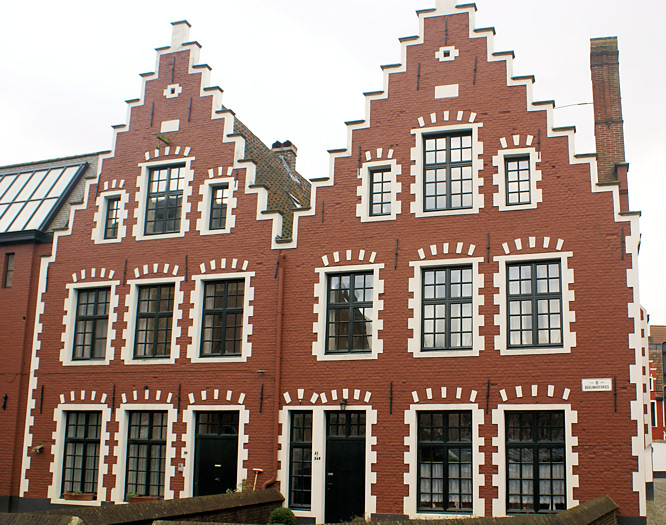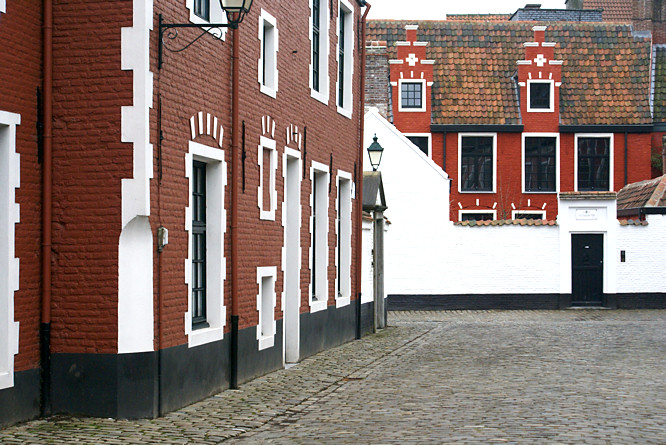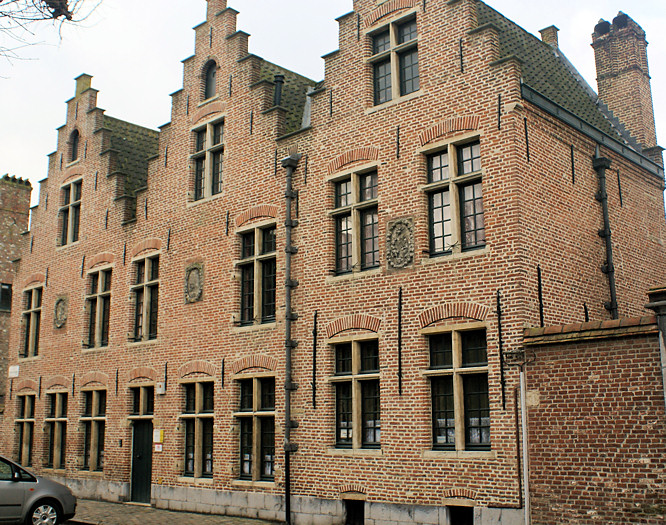Ghent Old town Area Oud Begijnhof
The residential area of Begijnhof in Ghent is not publicised by travel guides or the tourist office. It is an architectural gem. I discovered it by accident walking back from looking at the Het Rabot two towered fortified water gateway.

You will find the Begijnhof quarter to the west of the Gravensteen castle of the Counts: about a 10 minute walk away. You will find the most attractive buildings in the area bordered by the following roads; Edmond Boonstraat, Begijnhoflaan, Jan Verspeyenstraat and Rabotstraat. The characteristic stepped gable roofed buildings are the most common architectural style. Some have the year of construction stuck on the front facade.
In England around 1666 King Charles II was on the throne and great fire of London destroyed a large proportion of the city. Most of the London buildings were made of wood and thatched in straw. In Ghent house building started in the Begijnhof quarter using brick a safer and more radical and modern building materal.

Beguinages (begijnhoven, in Flemish) date from the 13th century. I had never heard of them before my trip to Ghent. At that time in history women greatly outnumbered men. There was a huge imbalance in the population. Men were decimated in local wars and the Crusades. They worked in high risk jobs. There was no health and safety executive to come to the rescue of the castle and warehouse construction workers crushed by falling masonry.
Life was cheap. Female virtue was under threat. Women were unprotected, widows as well as girls, were considered a surplus commodity. They had a limited economic use. Some were a social liability. They had to be fed and housed. There was no one to look after them. They decided to group together for defence and mutual support.
They became known as the Beguines. They wore nun like robes and coif, a close fitting cap that covers the top, back, and sides of the head. They had a reputation for sanctity and a contemplative life of devotion to god and each other. Apart from religious services and communal or private prayers, holy devotion to the saints also played an important role. As an institution they were self-sufficient.

The Beguines took vows of chastity, hard work and obedience to a Grand lady or Mother Superior just like nuns. The difference was that their vows were temporary and reversible. The Grand ladies were elected for terms of two or three years. The Beguines were allowed to retaining their personal property. This allowed them to preserve some notion of individuality. The Beguinages paid no revenues to the church.
Some of the women in the Beguines were married but their husbands had gone away to war or on a trade mission. They remained free to leave the Beguinage and resume their old lives when their husbands. The Flemish Beguines were renowned making a living in the textile industry; spinning, embroidery, lace making, weaving or bleaching. They also made sweets. They kept gardens to grow food for home use and sale in the markets. The Women of the Beguines were known for helping the poor and nursing the sick. Ghent's Klein Begijnhof is a school for handicapped children.
Beguinages, were enclosed spaces, usually surrounded by high brick walls. Today Ghent's Beguinage is an oasis in the centre of the city that seems to keep the 21st century out. The traffic rumble seems to disappear. It is like a separate town within the city. I loved exploring the alleyways that run behind some of the houses passing the walled gardens. The street scenes seem familiar but exotic. You have seen this view before but cannot place it. Then it dawns on you that these are the same houses you have seen in old Dutch paintings. It is as if time has stood still. You are walking through history, although a restored history.
The church lies in the centre of the beguinages and there was an infirmary nearby. Communal dwellings that would house novices and the less wealthy beguines were part of the complex. They provided a space to work and live under the leadership of the Grand lady. Once a beguine was accepted into the community she was allowed, if she had the financial resources, to buy or rent a house in the beguinage. After her death the house would return to the community.
It was seen by the aristocrats as worthwhile act of charity to financially support the Beguinages. They believed it would help them get into heaven and it made them look good with the general populace. The countesses of Flanders, especially Johanna and Margaretha of Constantinople, supported the beguinages. Little is known about the period before the 16th century. During the religious upheavals of the second half of the 16th century the Ghent beguinages were damaged but not destroyed. They flourished again at the beginning of the 17th century during the counter-reformation when most of the old buildings were renovated and built of brick.
In the second half of the 19th century were straightened and broadened and many houses, garden-walls and gardens disappeared. At the corner of the Gravin Johannastraat and the Begijnhofdries are the house of the Grand lady and the former infirmary with its chapel. These are all examples of baroque architecture. The house of the Grand lady consists of two wings built respectively in 1661 to 1662 and in 1738.
Travel books

